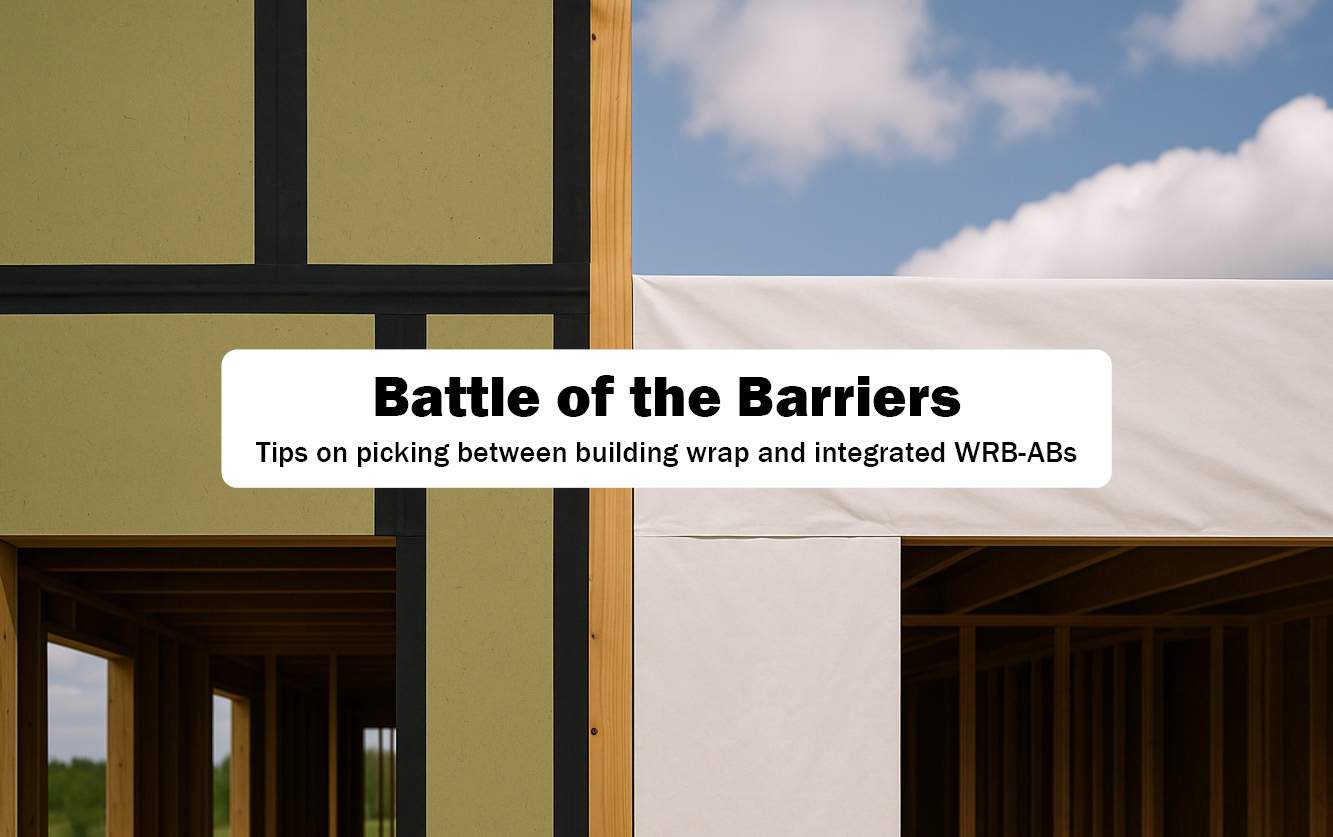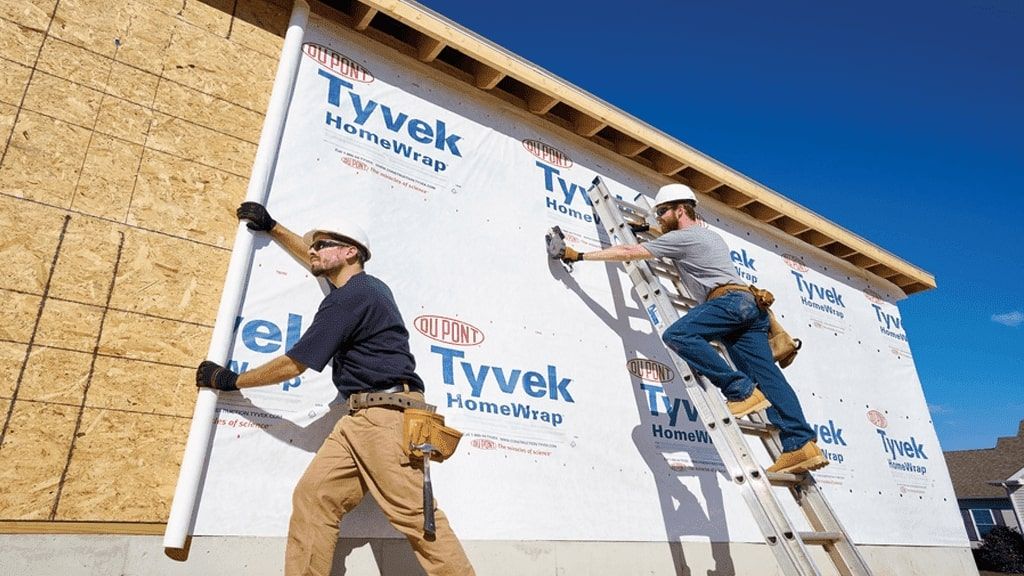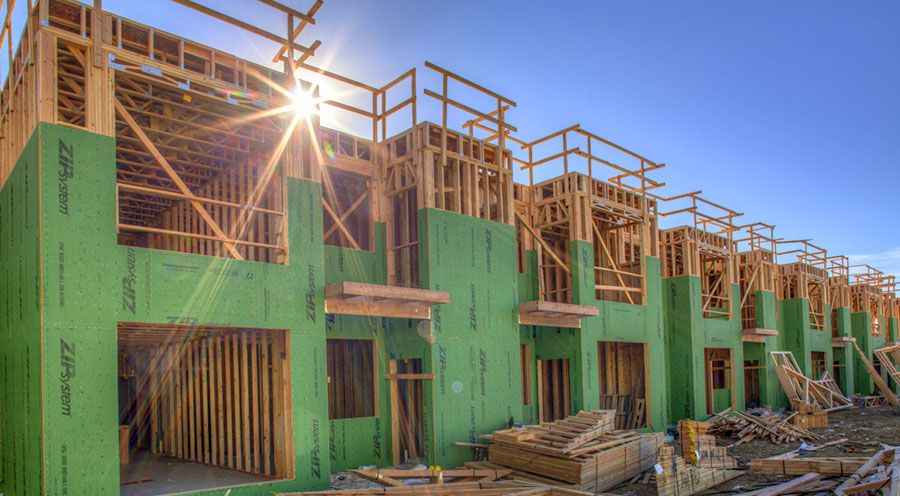
In the world of construction, there’s a lot of talk about building the “perfect” wall system that checks every box. One of the biggest boxes is moisture control.
But here’s the truth: moisture always finds a way in, whether through tiny gaps or vapor diffusion. That’s why modern building science isn’t chasing perfection, it’s chasing balance. When designing a wall with moisture in mind, there should be two goals:
- Minimize how much moisture and air can enter the assembly.
- Give the moisture that does enter a way to dry and exit the assembly
If a wall assembly can’t dry, it’s not a matter of if there will be damage – it’s when. Vancouver’s leaky condo crisis was a painful example of this where widespread failures in moisture protection led to billions of dollars of damage and a total rethink of how we build in high moisture areas.
Building wraps are a time-tested solution to manage moisture. But sheathings systems with integrated water-resistive barriers and air barriers (WRB-AB) are becoming more popular. They promise faster installation and reduced labor without compromising quality by combining wall layers into one product.
At SIS Panels, we manufacture insulated sheathing using materials our clients specify, including the integrated WRB-ABs when requested. But it leads to a common question – should builders go with traditional sheet-style building wrap, or the newer all-in-one sheathings?
Both have their advantages and tradeoffs. Let’s break down these differences so you can determine which is right for your project.
Disclaimer
SIS Panels does not manufacture, endorse, or promote any of the branded products referenced in this blog post. Any mention of branded products are provided solely as illustrative examples. Product suitability depends on various factors including local building codes, contractor expertise, material compatibility, project timelines, and climate conditions.
To maintain objectivity, this article was developed using a combination of resources from manufacturers of both style of solutions as well as independent third-party references to offer a balanced perspective. See the bottom of the article for sources used.
Sheet Style Building Wrap

Building wraps like Tyvek, Titan, Everbilt, RainDrop, have been around for decades. Many of these are made of high-density and highly durable polyethylene fibers that are bonded into a breathable sheet that resists moisture and air from getting into the assembly.
Pros of Building Wrap
Easy To Install
Sheets goods are straightforward to install over open studs, sheathing, or insulated sheathing. This simplicity can lead to fast installation times from contractors familiar with building wraps and makes it easy to learn and master for newer contractors.
Tear Resistant, Durable, & Repairable
Building wraps are typically made with nonwoven material that resists job-site punctures. If building wrap does get torn during construction, small holes can be sealed with the appropriate tape and large holes can be patched with a larger piece of building wrap. This process is simpler and less labor intensive compared to the sheathings with an integrated WRB
Proven Track Record
Building wraps have a long-standing history and are trusted by professionals across North America. Thousands upon thousands of buildings are protected by building wraps.
Installed Rain or Shine
Installation can continue in wet conditions so if an unexpected downpour happens, the vulnerable building framing can be protected at a moment’s notice.
Less Taping & Detailed Work Required
Building wrap requires less taping compared to the integrated WRB-AB systems, tape is primarily around openings and horizontal seams. This lowers the margin for error and adds to the simplicity mentioned above. Many of the installation guides call for at least several inches of overlap at the seams to protection at joints.
Widely Available
Building wrap’s widespread use and competition between brands has led to building wrap being a cost-effective way to protect a structure from moisture.
Integrated WRB-AB systems are still considered a commodity in some areas of North America and can be more difficult to source, adding to costs and project timelines.
Cons of Building Wrap
Vulnerable to Wind Gusts
Strong wind gusts can dislodge building wraps from the structure, potentially exposing the structure to moisture. If the building sits for a time before the exterior finish in installing, this can lead to damage.
Requires an Additional Trip Around the Building.
Installers are required to make a separate trip around the building to install building wrap. Builders may need to wait for local jurisdictions to inspect the wall before they can proceed with the next construction phase.
Potential of a Reverse Lap
A reverse lap is when the top piece of tape or material ends up tucked under the bottom piece. Think of it like this: Imagine you’re wearing a rain jacket, but you tuck the bottom of your jacket into the top of your pants. Now rain can drip right inside your pants instead of sliding off. That’s a reverse lap. Uncomfortable… and wet.
With house wrap, this can occur at horizontal seams that are taped to reduce air leakage. Improper installation can lead to a reverse lap. While there typically is a large amount of overlap (top layer over the bottom layer) that can reduce the risk, it does not outright prevent moisture from penetrating into the structure.
Sheathing with Integrated WRB-AB

Products like ZIP System Sheathing by Huber Engineered Wood, ForceField Weather Barrier System and DensElement Barrier System by Georgia-Pacific, and WeatherLogic by LP are just a handful of the products and systems with integrated WRB-AB.
They combine structural sheathing with a continuous air barrier and integrated water-resistive barrier for a quick & simple two-step installation that eliminates the need for building wraps.
Pros of Integrated WRB-AB
Simplified Installation Process
Integrated WRB-ABs provide an all-in-one solution for wall construction by combining multiple steps into one. Install the sheathing, seal the joints & fasteners, and the structure is protected against moisture and air.
This also has the potential to speed up the installation process. For example, Huber markets that the ZIP System can be up to 40% faster to install compared to building wraps.
Variety of Available Accessory Products
To seal the joints and fasteners, manufactuers have a variety of products to help installers work faster and easier. This includes tapes that are stretchable to give installers more flexibility as well as liquid flashing for applications like circular or irregular shapred penetrations. The manufacturer’s have made an effort to give installers the tools they need to work in a variety of conditions.
Better Sealing Capabilities
Because the WRB is integrated into the board, after a well done taping job the home will be extremely secure to water. This level of protection would normally take longer. Many of these systems also have options of both tape and liquid flashing to simplify sealing problem areas such as irregular shaped penetrations.
Warranty
Warranty is available on select integrated sheathing systems of up to 30 years. This is notably longer than some of the warranties available on building wraps.
Cons of Integrated WRB-AB
Weather-Dependent Installation
The accessories these systems require, like the tapes, is optimally used in warm conditions. In the winter during cold periods, you can leave the tape to warm in vehicles then quickly apply it, however this is not recommended and can result in project delays.
Manufactuer instruction often require these accessories to be applied to clean, dry surfaces that are free of dirt, dust and frost. Contact of the adhesive surfaces with any foreign matter that may affect the bond must also be avoided. Moisture will always find the route of least resistance through a wall assembly.
Requires Extensive Sealing with High Risk & High Reward
All joints need to be sealed which can result in higher material and labor costs compared to other options.
Installers need to be careful when fastening into Sheathing with Integrated WRB-AB as countersinking the fasteners will effectively break the WRB and create the potential for moisture damage. If you are considering using Sheathing with Integrated WRB-AB, make sure the installers are sealing all fasteners as one mistake can lead to significant damage.
Potential of Voided Warranty
Although a select number of these solutions have notably longer warranty compared to building wraps, installers are required to thoroughly follow installation instructions to not void the warranty.
Some potential reasons for voided warrnaty include installation in improper weather conditions, if the tape wrinkles, if a 3rd party WRB is used, etc.
Potential of a Reverse Lap
Proper tape installation should be like roof shingles or fish scales – each layer overlapping the one below it so water flows down and away. Since the integrated sheathing panels don’t overlap and typically have a small gap between them, it’s extra important to avoid reverse laps by using the proper tools and appropriate liquid flashings to seal it all tight. This applies to all openings like windows, doors, pipes, etc.
Large Repairs Require Additonal Work
Damage that is too large to repair with tape must be repaired by removing the damaged area and replacing it with a similarly sized piece of integrated sheathing. This typically involves installing blocking and other structural framing members to account for this new piece.
Bottom Line: Choose What Fits Your Project and Crew

Both systems can perform well but only with proper installation. That’s why we recommend choosing the option that you or your contractor are most familiar with. There is no universal best choice and local knowledge and proper building code compliance can make the difference between a project going smoothly or turning into an expensive mess.
When deciding what type of solution to use, ask yourself questions like:
- Has my crew ever used an integrated WRB-AB?
- How available are integrated WRB-AB systems?
- Are we building in a high wind area?
- Is the building going to sit for a while before we can install the exterior finish?
- Does the project require a fire-rating?
Whatever direction you choose, SIS Panels can build insulated sheathing to match your approach — whether that’s using integrated WRB systems or traditional building wraps. We’ll work with your preferred materials to support your project goals from the ground up. Contact us today to get started.
Disclaimer
SIS Panels does not manufacture, endorse, or promote any of the branded products referenced in this blog post. These mentions are provided solely as illustrative examples. Product suitability depends on various factors including local building codes, contractor expertise, material compatibility, project timelines, and climate conditions.
For optimal outcomes, we strongly recommend consulting with qualified professionals such as building envelope experts, architects, and insurance advisors to assess product compatibility and ensure long-term performance.
To maintain objectivity, this article was developed using a combination of resources from manufacturers of both build wraps and integrated WRB-ABs as well as independent third-party references to offer a balanced perspective.
ZIP System® vs. Tyvek® HomeWrap® by Dupont
Integrated Water-Resistive Barrier or Housewrap? There is No Question by Huber Engineered Woods
White Paper by Jeff Hoch & Mark Crawford
